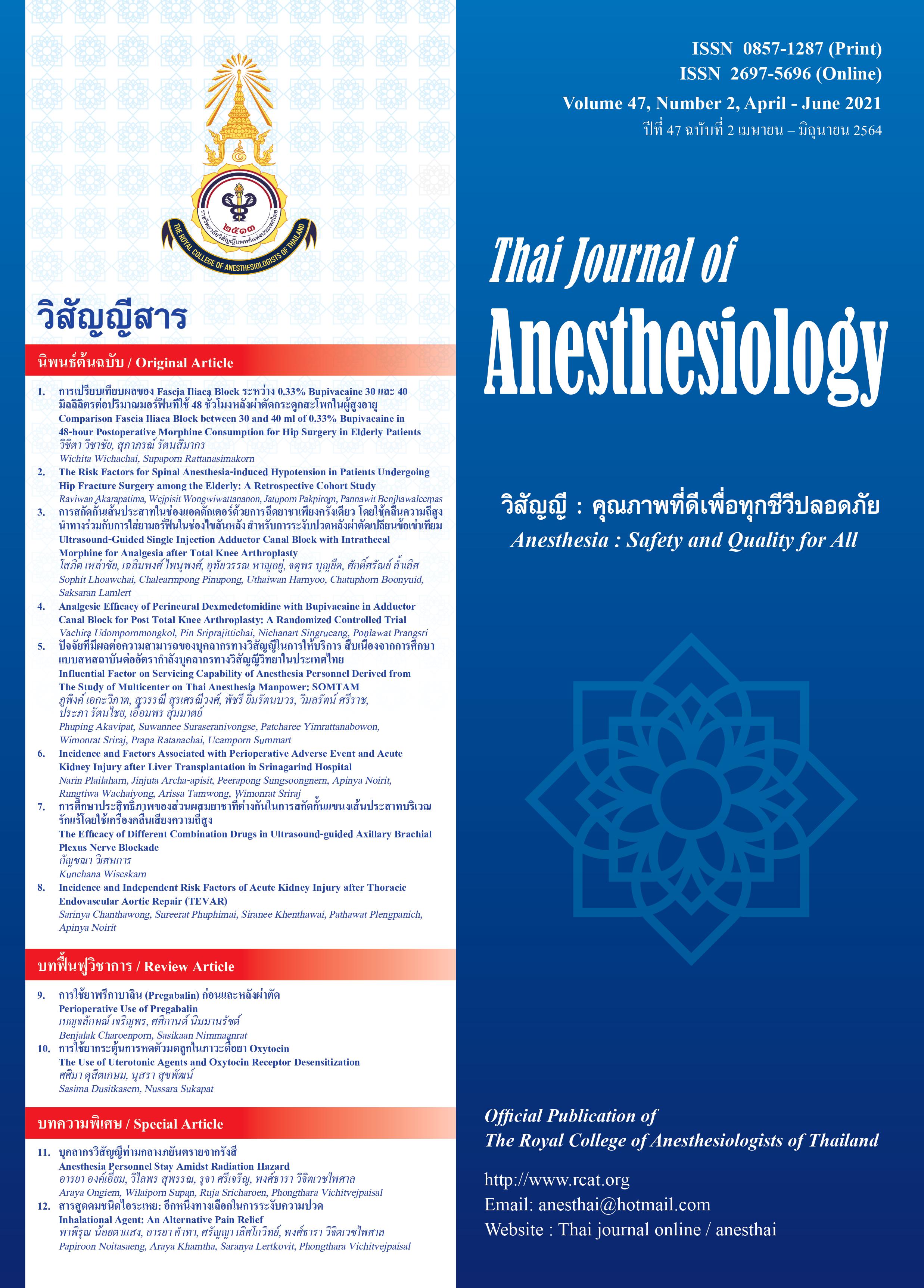Analgesic Efficacy of Perineural Dexmedetomidine with Bupivacaine in Adductor Canal Block for Post Total Knee Arthroplasty: A Randomized Controlled Trial
Main Article Content
Abstract
Background: Total knee arthroplasty (TKA) surgery is associated with severe postoperative pain. Currently, adductor canal block (ACB) is a widely used method to provide analgesia after TKA. Objectives: The primary objective was to study the analgesic efficacy of perineural dexmedetomidine with bupivacaine in ACB in patients undergoing TKA, and the secondary objectives were to investigate the ambulation ability and the side effects. Methods: Sixty patients aged 18-85 years, ASA status I-III underwent primary, unilateral TKA under spinal anesthesia. They were randomized into two groups; Group C received 20 mL of 0.25% bupivacaine and Group D received 20 mL of 0.25% bupivacaine plus 0.5 mcg/kg dexmedetomidine for ACB. The time to first rescue analgesia, 24-hour morphine consumption, postoperative pain score, quadriceps strength, the Timed Up and Go (TUG) test, patient satisfaction, and adverse outcomes were assessed. Results: The patient demographic and intraoperative data were comparable in both groups. The median time to first rescue analgesia (group C: 196 [89, 363], group D: 184 [105, 267], and P-value = 0.112), 24-hour morphine consumption (group C: 6.5 [4, 10], group D: 9 [3.25, 14.50] and P-value = 0.245) and postoperative pain score at rest and on movement (P-value = 0.829 and 0.888, respectively) showed no significant differences between groups. There were no significant differences in TUG test, quadriceps strength, adverse events, and patient satisfaction between groups. Conclusion: The addition dexmedetomidine to bupivacaine was not better than single-shot ACB regarding postoperative analgesia and ambulation ability following TKA.
Article Details
References
techniques for total knee replacement. Curr Opin Anaesthesiol
2014;27:501-6.
2. Ellis TA 2nd, Hammoud H, Dela Merced P, et al. Multimodal
clinical pathway with adductor canal block decreases hospital
length of stay, improves pain control, and reduces opioid
consumption in total knee arthroplasty patients: a retrospective
review. J Arthroplasty 2018;33:2440-8.
3. Laurant DBS, Peng P, Arango LG, et al. The nerves of the
adductor canal and the innervation of the knee: an anatomic
study. Reg Anesth Pain Med 2016;41:321-7.
4. Sørensen JK, Jæger P, Dahl JB, et al. The isolated effect of
adductor canal block on quadriceps femoris muscle strength
after total knee arthroplasty: a triple-blinded, randomized,
placebo-controlled trial with individual patient analysis.
Anesth Analg 2016;122:553-8.
5. Jiang X, Wang QQ, Wu CA, Tian W. Analgesic efficacy of
adductor canal block in total knee arthroplasty: a metaanalysis and systematic review. Orthop Surg 2016;8:
294-300.
6. Kuang MJ, Xu LY, Ma JX, et al. Adductor canal block versus
continuous femoral nerve block in primary total knee
arthroplasty: a meta-analysis. Int J Surg 2016;31:17-24.
7. Thacher RR, Hickernell TR, Grosso MJ, et al. Decreased risk
of knee buckling with adductor canal block versus femoral
nerve block in total knee arthroplasty: a retrospective cohort
study. Arthroplast Today 2017;3:281-5.
8. Neal JM, Salinas FV, Choi DS. Local anesthetic-induced
myotoxicity after continuous adductor canal block. Reg
Anesth Pain Med 2016;41:723-27.
9. Turner JD, Dobson SW, Henshaw DS, et al. Single-injection
adductor canal block with multiple adjuvants provides
equivalent analgesia when compared with continuous
adductor canal blockade for primary total knee arthroplasty:
a double-blinded, randomized, controlled, equivalency trial.
J Arthroplasty 2018;33:3160-6. E1.
10. Abdallah FW, Brull R. Facilitatory effects of perineural
dexmedetomidine on neuraxial and peripheral nerve block:
a systematic review and meta-analysis. Br J Anaesth 2013;
110: 915-25.
11. Kang Z, Xie W, Xie W, Li S, Chen R. Comparison of neurotoxicity
of dexmedetomidine as an adjuvant in brachial plexus block
in rats of different age. Neurotoxicol Teratol 2018;69:21-6.
12. Memari E, Hosseinian MA, Mirkheshti A, et al. Comparison
of histopathological effects of perineural administration of
bupivacaine and bupivacaine-dexmedetomidine in rat sciatic
nerve. Exp Toxicol Pathol 2016;68:559-64.
13. Agarwal S, Aggarwal R, Gupta P. Dexmedetomidine prolongs
the effect of bupivacaine in supraclavicular brachial plexus
block. J Anaesthesiol Clin Pharmacol 2014;30:36-40.
14. Packiasabapathy SK, Kashyap L, Arora MK, et al. Effect of
dexmedetomidine as an adjuvant to bupivacaine in femoral
nerve block for perioperative analgesia in patients
undergoing total knee replacement arthroplasty: A doseresponse study. Saudi J Anaesth 2017;11:293-8.
15. Goyal R, Mittal G, Yadav AK, Sethi R, Chattopadhyay A.
Adductor canal block for postoperative analgesia
after simultaneous bilateral total knee replacement:
A randomised controlled trial to study the effect of addition
of dexmedetomidine to ropivacaine. Indian J Anaesth
2017;61:903-9.
16 . Ortiz-Gomez JR, Pereperez-Candel M, Vazquez-Torres JM,
et al. Postoperative analgesia for elective total knee
arthroplasty under subarachnoid anesthesia with opioids:
comparison between epidural, femoral block and adductor
canal block techniques (with and without perineural
adjuvants). A prospective, randomized, clinical trial. Minerva
Anestesiol 2017;83:50-8.
17. Raeder, Johan, Spreng UJ. Intra-articular and periarticular
infiltration of local anesthetics. In: Hadzic A, editor. Hadzic’s
textbook of regional anesthesia and acute pain management.
2nd ed. New York: McGraw-Hill Education; 2017.
18. Tsukada S, Wakui M. Combined intravenous and
intra-articular tranexamic acid in simultaneous bilateral total
knee arthroplasty without tourniquet use. JBJS Open Access
2017;2:E0002.
19. Wong WY, Bjørn S, Strid JMC, Børglum J, Bendtsen TF.
Defining the location of the adductor canal using ultrasound.
Reg Anesth Pain Med 2017;42:241-5.
20. Kampitak W, Tanavalee A, Ngarmukos S, et al. Does adductor
canal block have a synergistic effect with local infiltration
analgesia for enhancing ambulation and improving analgesia
after total knee arthroplasty? Knee Surg Relat Res 2018;
30:133-41.
21. Andersen JH, Grevstad U, Siegel H, et al. Does dexmedetomidine
have a perineural mechanism of action when used as an
adjuvant to ropivacaine?: A paired, blinded, randomized
trial in healthy volunteers. Anesthesiology 2017;126:66-73.
22. Naaz S, Ozair E. Dexmedetomidine in current anaesthesia
practice- a review. J Clin Diagn Res 2014;8:GE01-4.
23. Jaeger P, Zaric D, Fomsgaard JS, et al. Adductor canal block
versus femoral nerve block for analgesia after total knee
arthroplasty: a randomized, double-blind study. Reg Anesth
Pain Med 2013; 38:526-32.
24. Stevens-Lapsley JE, Balter JE, Kohrt WM, Eckhoff DG.
Quadriceps and hamstrings muscle dysfunction after total
knee arthroplasty. Clin Orthop Relat Res2010; 468:2460-8.


